Literature Review: Terrorism Impact on Five-Star Hotels in Antalya
VerifiedAdded on 2023/06/11
|10
|3973
|164
Literature Review
AI Summary
This literature review examines the impact of crisis management strategies on five-star hotels in Antalya, Turkey, focusing on the effects of terrorism. It delves into key theories such as Situational Crisis Communication Theory, Contingency Theory, and Diffusion of Innovation Theory, analyzing how these frameworks inform crisis response in the hospitality sector. The review also explores existing research on tourism crisis management, differentiating between studies focused on consumer perspectives and those examining hotel strategies. Ultimately, the literature review aims to provide a comprehensive understanding of the challenges and approaches to crisis management in the context of Antalya's tourism industry. Desklib provides access to past papers and solved assignments for students.
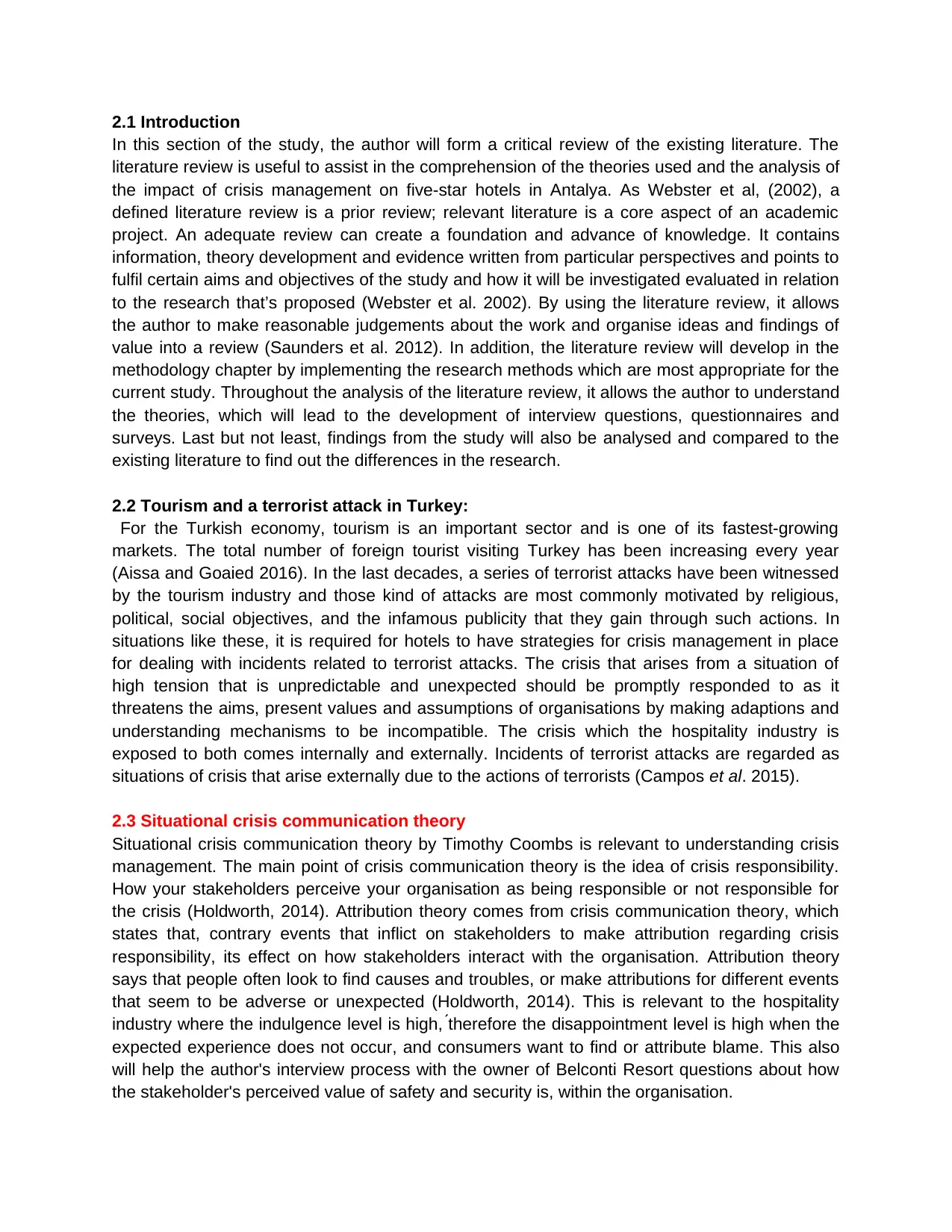
2.1 Introduction
In this section of the study, the author will form a critical review of the existing literature. The
literature review is useful to assist in the comprehension of the theories used and the analysis of
the impact of crisis management on five-star hotels in Antalya. As Webster et al, (2002), a
defined literature review is a prior review; relevant literature is a core aspect of an academic
project. An adequate review can create a foundation and advance of knowledge. It contains
information, theory development and evidence written from particular perspectives and points to
fulfil certain aims and objectives of the study and how it will be investigated evaluated in relation
to the research that’s proposed (Webster et al. 2002). By using the literature review, it allows
the author to make reasonable judgements about the work and organise ideas and findings of
value into a review (Saunders et al. 2012). In addition, the literature review will develop in the
methodology chapter by implementing the research methods which are most appropriate for the
current study. Throughout the analysis of the literature review, it allows the author to understand
the theories, which will lead to the development of interview questions, questionnaires and
surveys. Last but not least, findings from the study will also be analysed and compared to the
existing literature to find out the differences in the research.
2.2 Tourism and a terrorist attack in Turkey:
For the Turkish economy, tourism is an important sector and is one of its fastest-growing
markets. The total number of foreign tourist visiting Turkey has been increasing every year
(Aissa and Goaied 2016). In the last decades, a series of terrorist attacks have been witnessed
by the tourism industry and those kind of attacks are most commonly motivated by religious,
political, social objectives, and the infamous publicity that they gain through such actions. In
situations like these, it is required for hotels to have strategies for crisis management in place
for dealing with incidents related to terrorist attacks. The crisis that arises from a situation of
high tension that is unpredictable and unexpected should be promptly responded to as it
threatens the aims, present values and assumptions of organisations by making adaptions and
understanding mechanisms to be incompatible. The crisis which the hospitality industry is
exposed to both comes internally and externally. Incidents of terrorist attacks are regarded as
situations of crisis that arise externally due to the actions of terrorists (Campos et al. 2015).
2.3 Situational crisis communication theory
Situational crisis communication theory by Timothy Coombs is relevant to understanding crisis
management. The main point of crisis communication theory is the idea of crisis responsibility.
How your stakeholders perceive your organisation as being responsible or not responsible for
the crisis (Holdworth, 2014). Attribution theory comes from crisis communication theory, which
states that, contrary events that inflict on stakeholders to make attribution regarding crisis
responsibility, its effect on how stakeholders interact with the organisation. Attribution theory
says that people often look to find causes and troubles, or make attributions for different events
that seem to be adverse or unexpected (Holdworth, 2014). This is relevant to the hospitality
industry where the indulgence level is high, ́ therefore the disappointment level is high when the
expected experience does not occur, and consumers want to find or attribute blame. This also
will help the author's interview process with the owner of Belconti Resort questions about how
the stakeholder's perceived value of safety and security is, within the organisation.
In this section of the study, the author will form a critical review of the existing literature. The
literature review is useful to assist in the comprehension of the theories used and the analysis of
the impact of crisis management on five-star hotels in Antalya. As Webster et al, (2002), a
defined literature review is a prior review; relevant literature is a core aspect of an academic
project. An adequate review can create a foundation and advance of knowledge. It contains
information, theory development and evidence written from particular perspectives and points to
fulfil certain aims and objectives of the study and how it will be investigated evaluated in relation
to the research that’s proposed (Webster et al. 2002). By using the literature review, it allows
the author to make reasonable judgements about the work and organise ideas and findings of
value into a review (Saunders et al. 2012). In addition, the literature review will develop in the
methodology chapter by implementing the research methods which are most appropriate for the
current study. Throughout the analysis of the literature review, it allows the author to understand
the theories, which will lead to the development of interview questions, questionnaires and
surveys. Last but not least, findings from the study will also be analysed and compared to the
existing literature to find out the differences in the research.
2.2 Tourism and a terrorist attack in Turkey:
For the Turkish economy, tourism is an important sector and is one of its fastest-growing
markets. The total number of foreign tourist visiting Turkey has been increasing every year
(Aissa and Goaied 2016). In the last decades, a series of terrorist attacks have been witnessed
by the tourism industry and those kind of attacks are most commonly motivated by religious,
political, social objectives, and the infamous publicity that they gain through such actions. In
situations like these, it is required for hotels to have strategies for crisis management in place
for dealing with incidents related to terrorist attacks. The crisis that arises from a situation of
high tension that is unpredictable and unexpected should be promptly responded to as it
threatens the aims, present values and assumptions of organisations by making adaptions and
understanding mechanisms to be incompatible. The crisis which the hospitality industry is
exposed to both comes internally and externally. Incidents of terrorist attacks are regarded as
situations of crisis that arise externally due to the actions of terrorists (Campos et al. 2015).
2.3 Situational crisis communication theory
Situational crisis communication theory by Timothy Coombs is relevant to understanding crisis
management. The main point of crisis communication theory is the idea of crisis responsibility.
How your stakeholders perceive your organisation as being responsible or not responsible for
the crisis (Holdworth, 2014). Attribution theory comes from crisis communication theory, which
states that, contrary events that inflict on stakeholders to make attribution regarding crisis
responsibility, its effect on how stakeholders interact with the organisation. Attribution theory
says that people often look to find causes and troubles, or make attributions for different events
that seem to be adverse or unexpected (Holdworth, 2014). This is relevant to the hospitality
industry where the indulgence level is high, ́ therefore the disappointment level is high when the
expected experience does not occur, and consumers want to find or attribute blame. This also
will help the author's interview process with the owner of Belconti Resort questions about how
the stakeholder's perceived value of safety and security is, within the organisation.
Paraphrase This Document
Need a fresh take? Get an instant paraphrase of this document with our AI Paraphraser
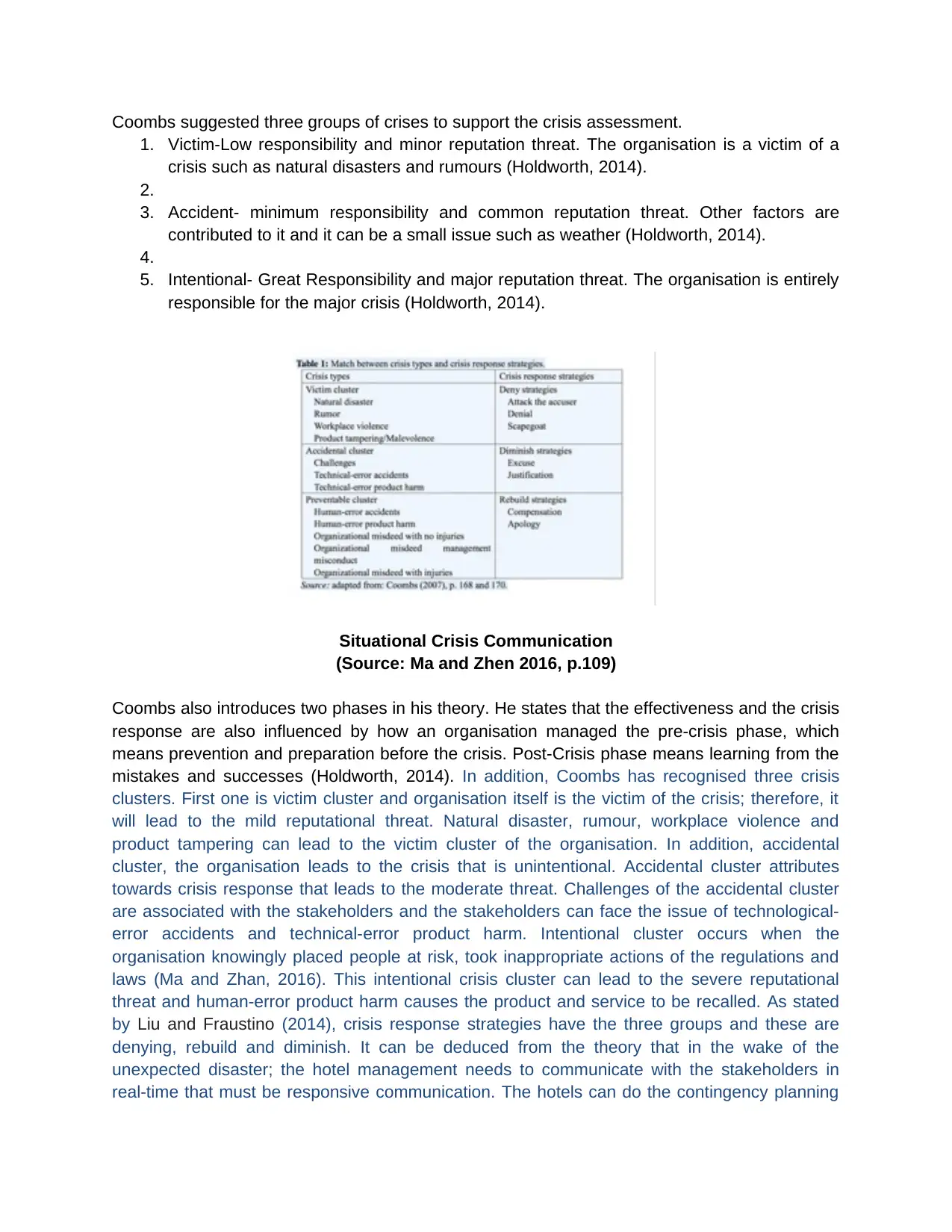
Coombs suggested three groups of crises to support the crisis assessment.
1. Victim-Low responsibility and minor reputation threat. The organisation is a victim of a
crisis such as natural disasters and rumours (Holdworth, 2014).
2.
3. Accident- minimum responsibility and common reputation threat. Other factors are
contributed to it and it can be a small issue such as weather (Holdworth, 2014).
4.
5. Intentional- Great Responsibility and major reputation threat. The organisation is entirely
responsible for the major crisis (Holdworth, 2014).
Situational Crisis Communication
(Source: Ma and Zhen 2016, p.109)
Coombs also introduces two phases in his theory. He states that the effectiveness and the crisis
response are also influenced by how an organisation managed the pre-crisis phase, which
means prevention and preparation before the crisis. Post-Crisis phase means learning from the
mistakes and successes (Holdworth, 2014). In addition, Coombs has recognised three crisis
clusters. First one is victim cluster and organisation itself is the victim of the crisis; therefore, it
will lead to the mild reputational threat. Natural disaster, rumour, workplace violence and
product tampering can lead to the victim cluster of the organisation. In addition, accidental
cluster, the organisation leads to the crisis that is unintentional. Accidental cluster attributes
towards crisis response that leads to the moderate threat. Challenges of the accidental cluster
are associated with the stakeholders and the stakeholders can face the issue of technological-
error accidents and technical-error product harm. Intentional cluster occurs when the
organisation knowingly placed people at risk, took inappropriate actions of the regulations and
laws (Ma and Zhan, 2016). This intentional crisis cluster can lead to the severe reputational
threat and human-error product harm causes the product and service to be recalled. As stated
by Liu and Fraustino (2014), crisis response strategies have the three groups and these are
denying, rebuild and diminish. It can be deduced from the theory that in the wake of the
unexpected disaster; the hotel management needs to communicate with the stakeholders in
real-time that must be responsive communication. The hotels can do the contingency planning
1. Victim-Low responsibility and minor reputation threat. The organisation is a victim of a
crisis such as natural disasters and rumours (Holdworth, 2014).
2.
3. Accident- minimum responsibility and common reputation threat. Other factors are
contributed to it and it can be a small issue such as weather (Holdworth, 2014).
4.
5. Intentional- Great Responsibility and major reputation threat. The organisation is entirely
responsible for the major crisis (Holdworth, 2014).
Situational Crisis Communication
(Source: Ma and Zhen 2016, p.109)
Coombs also introduces two phases in his theory. He states that the effectiveness and the crisis
response are also influenced by how an organisation managed the pre-crisis phase, which
means prevention and preparation before the crisis. Post-Crisis phase means learning from the
mistakes and successes (Holdworth, 2014). In addition, Coombs has recognised three crisis
clusters. First one is victim cluster and organisation itself is the victim of the crisis; therefore, it
will lead to the mild reputational threat. Natural disaster, rumour, workplace violence and
product tampering can lead to the victim cluster of the organisation. In addition, accidental
cluster, the organisation leads to the crisis that is unintentional. Accidental cluster attributes
towards crisis response that leads to the moderate threat. Challenges of the accidental cluster
are associated with the stakeholders and the stakeholders can face the issue of technological-
error accidents and technical-error product harm. Intentional cluster occurs when the
organisation knowingly placed people at risk, took inappropriate actions of the regulations and
laws (Ma and Zhan, 2016). This intentional crisis cluster can lead to the severe reputational
threat and human-error product harm causes the product and service to be recalled. As stated
by Liu and Fraustino (2014), crisis response strategies have the three groups and these are
denying, rebuild and diminish. It can be deduced from the theory that in the wake of the
unexpected disaster; the hotel management needs to communicate with the stakeholders in
real-time that must be responsive communication. The hotels can do the contingency planning
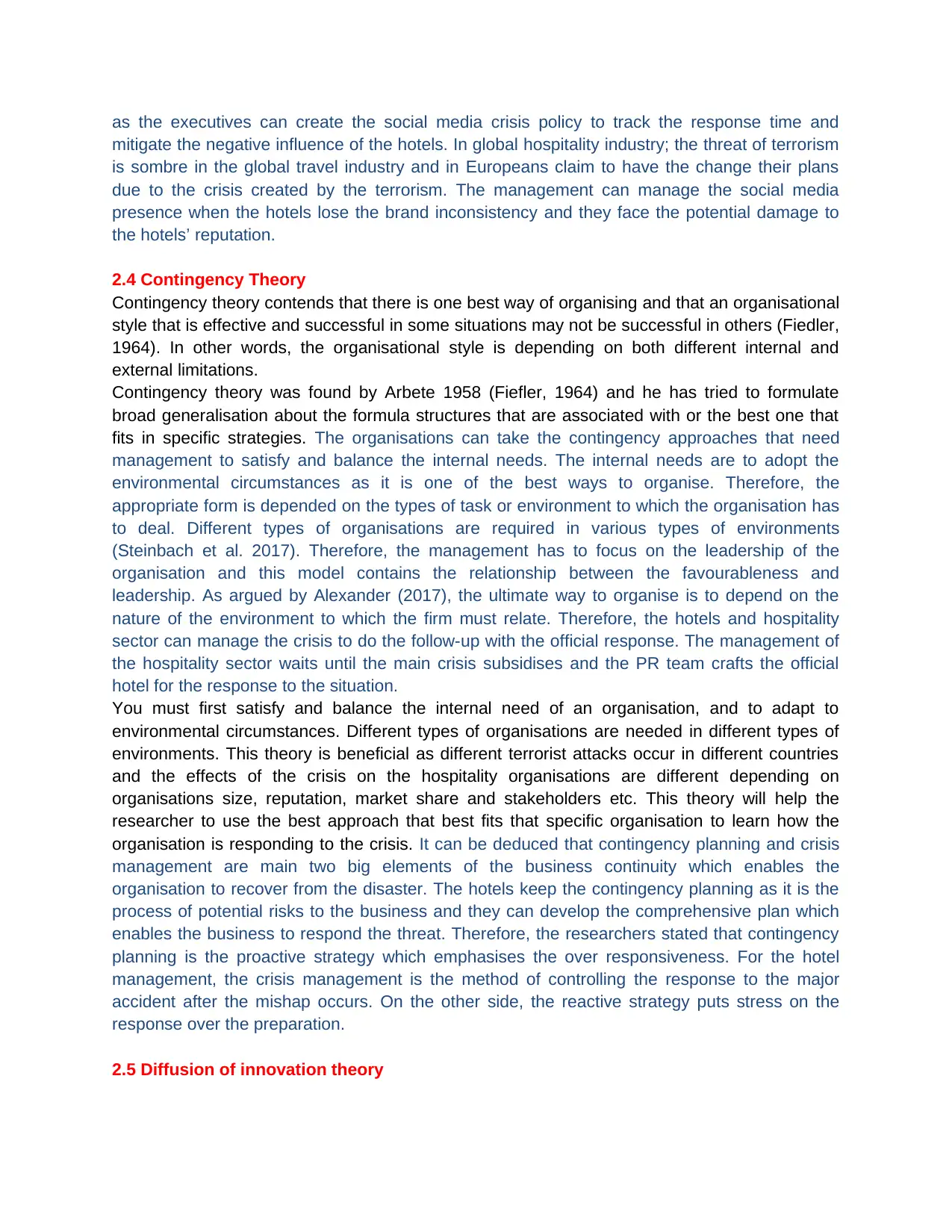
as the executives can create the social media crisis policy to track the response time and
mitigate the negative influence of the hotels. In global hospitality industry; the threat of terrorism
is sombre in the global travel industry and in Europeans claim to have the change their plans
due to the crisis created by the terrorism. The management can manage the social media
presence when the hotels lose the brand inconsistency and they face the potential damage to
the hotels’ reputation.
2.4 Contingency Theory
Contingency theory contends that there is one best way of organising and that an organisational
style that is effective and successful in some situations may not be successful in others (Fiedler,
1964). In other words, the organisational style is depending on both different internal and
external limitations.
Contingency theory was found by Arbete 1958 (Fiefler, 1964) and he has tried to formulate
broad generalisation about the formula structures that are associated with or the best one that
fits in specific strategies. The organisations can take the contingency approaches that need
management to satisfy and balance the internal needs. The internal needs are to adopt the
environmental circumstances as it is one of the best ways to organise. Therefore, the
appropriate form is depended on the types of task or environment to which the organisation has
to deal. Different types of organisations are required in various types of environments
(Steinbach et al. 2017). Therefore, the management has to focus on the leadership of the
organisation and this model contains the relationship between the favourableness and
leadership. As argued by Alexander (2017), the ultimate way to organise is to depend on the
nature of the environment to which the firm must relate. Therefore, the hotels and hospitality
sector can manage the crisis to do the follow-up with the official response. The management of
the hospitality sector waits until the main crisis subsidises and the PR team crafts the official
hotel for the response to the situation.
You must first satisfy and balance the internal need of an organisation, and to adapt to
environmental circumstances. Different types of organisations are needed in different types of
environments. This theory is beneficial as different terrorist attacks occur in different countries
and the effects of the crisis on the hospitality organisations are different depending on
organisations size, reputation, market share and stakeholders etc. This theory will help the
researcher to use the best approach that best fits that specific organisation to learn how the
organisation is responding to the crisis. It can be deduced that contingency planning and crisis
management are main two big elements of the business continuity which enables the
organisation to recover from the disaster. The hotels keep the contingency planning as it is the
process of potential risks to the business and they can develop the comprehensive plan which
enables the business to respond the threat. Therefore, the researchers stated that contingency
planning is the proactive strategy which emphasises the over responsiveness. For the hotel
management, the crisis management is the method of controlling the response to the major
accident after the mishap occurs. On the other side, the reactive strategy puts stress on the
response over the preparation.
2.5 Diffusion of innovation theory
mitigate the negative influence of the hotels. In global hospitality industry; the threat of terrorism
is sombre in the global travel industry and in Europeans claim to have the change their plans
due to the crisis created by the terrorism. The management can manage the social media
presence when the hotels lose the brand inconsistency and they face the potential damage to
the hotels’ reputation.
2.4 Contingency Theory
Contingency theory contends that there is one best way of organising and that an organisational
style that is effective and successful in some situations may not be successful in others (Fiedler,
1964). In other words, the organisational style is depending on both different internal and
external limitations.
Contingency theory was found by Arbete 1958 (Fiefler, 1964) and he has tried to formulate
broad generalisation about the formula structures that are associated with or the best one that
fits in specific strategies. The organisations can take the contingency approaches that need
management to satisfy and balance the internal needs. The internal needs are to adopt the
environmental circumstances as it is one of the best ways to organise. Therefore, the
appropriate form is depended on the types of task or environment to which the organisation has
to deal. Different types of organisations are required in various types of environments
(Steinbach et al. 2017). Therefore, the management has to focus on the leadership of the
organisation and this model contains the relationship between the favourableness and
leadership. As argued by Alexander (2017), the ultimate way to organise is to depend on the
nature of the environment to which the firm must relate. Therefore, the hotels and hospitality
sector can manage the crisis to do the follow-up with the official response. The management of
the hospitality sector waits until the main crisis subsidises and the PR team crafts the official
hotel for the response to the situation.
You must first satisfy and balance the internal need of an organisation, and to adapt to
environmental circumstances. Different types of organisations are needed in different types of
environments. This theory is beneficial as different terrorist attacks occur in different countries
and the effects of the crisis on the hospitality organisations are different depending on
organisations size, reputation, market share and stakeholders etc. This theory will help the
researcher to use the best approach that best fits that specific organisation to learn how the
organisation is responding to the crisis. It can be deduced that contingency planning and crisis
management are main two big elements of the business continuity which enables the
organisation to recover from the disaster. The hotels keep the contingency planning as it is the
process of potential risks to the business and they can develop the comprehensive plan which
enables the business to respond the threat. Therefore, the researchers stated that contingency
planning is the proactive strategy which emphasises the over responsiveness. For the hotel
management, the crisis management is the method of controlling the response to the major
accident after the mishap occurs. On the other side, the reactive strategy puts stress on the
response over the preparation.
2.5 Diffusion of innovation theory
⊘ This is a preview!⊘
Do you want full access?
Subscribe today to unlock all pages.

Trusted by 1+ million students worldwide
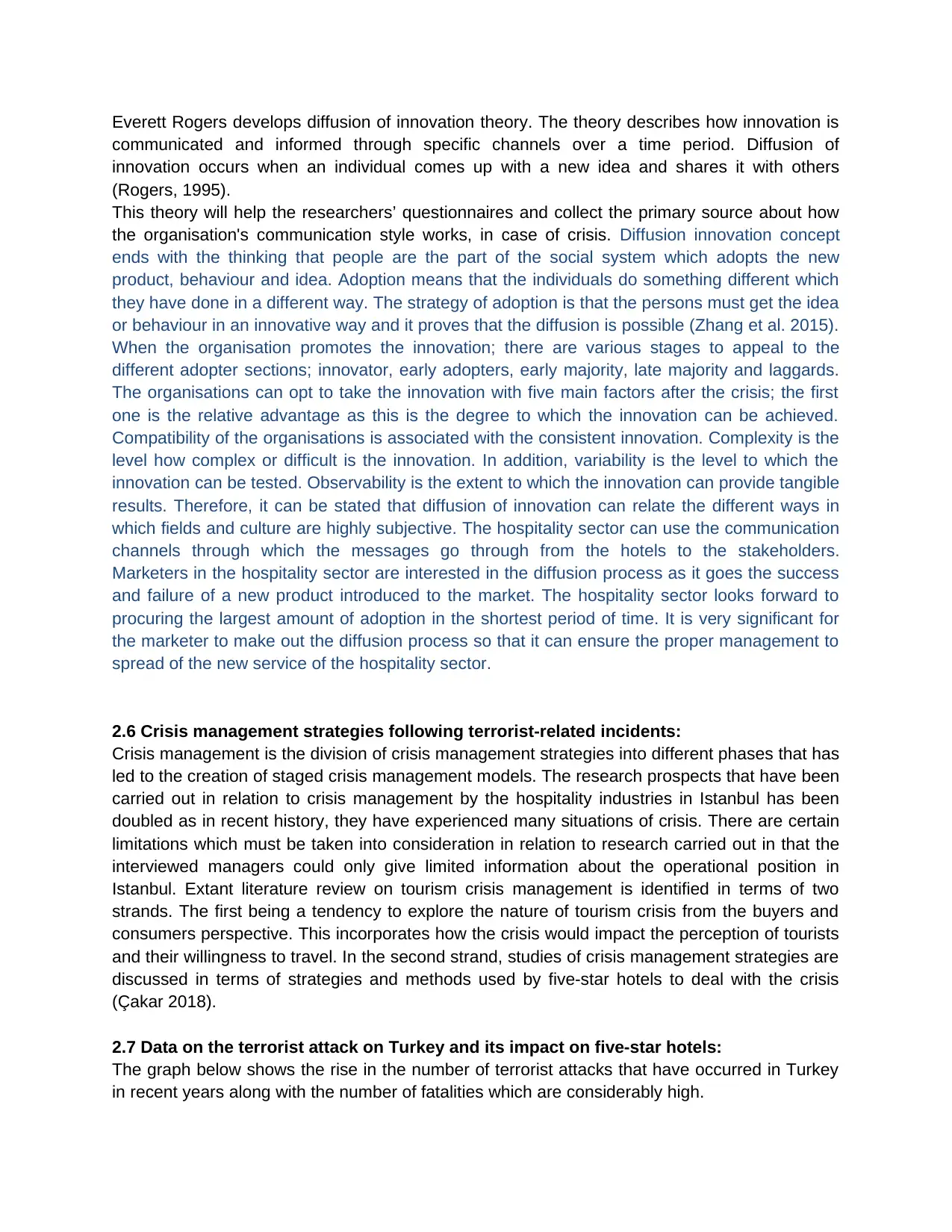
Everett Rogers develops diffusion of innovation theory. The theory describes how innovation is
communicated and informed through specific channels over a time period. Diffusion of
innovation occurs when an individual comes up with a new idea and shares it with others
(Rogers, 1995).
This theory will help the researchers’ questionnaires and collect the primary source about how
the organisation's communication style works, in case of crisis. Diffusion innovation concept
ends with the thinking that people are the part of the social system which adopts the new
product, behaviour and idea. Adoption means that the individuals do something different which
they have done in a different way. The strategy of adoption is that the persons must get the idea
or behaviour in an innovative way and it proves that the diffusion is possible (Zhang et al. 2015).
When the organisation promotes the innovation; there are various stages to appeal to the
different adopter sections; innovator, early adopters, early majority, late majority and laggards.
The organisations can opt to take the innovation with five main factors after the crisis; the first
one is the relative advantage as this is the degree to which the innovation can be achieved.
Compatibility of the organisations is associated with the consistent innovation. Complexity is the
level how complex or difficult is the innovation. In addition, variability is the level to which the
innovation can be tested. Observability is the extent to which the innovation can provide tangible
results. Therefore, it can be stated that diffusion of innovation can relate the different ways in
which fields and culture are highly subjective. The hospitality sector can use the communication
channels through which the messages go through from the hotels to the stakeholders.
Marketers in the hospitality sector are interested in the diffusion process as it goes the success
and failure of a new product introduced to the market. The hospitality sector looks forward to
procuring the largest amount of adoption in the shortest period of time. It is very significant for
the marketer to make out the diffusion process so that it can ensure the proper management to
spread of the new service of the hospitality sector.
2.6 Crisis management strategies following terrorist-related incidents:
Crisis management is the division of crisis management strategies into different phases that has
led to the creation of staged crisis management models. The research prospects that have been
carried out in relation to crisis management by the hospitality industries in Istanbul has been
doubled as in recent history, they have experienced many situations of crisis. There are certain
limitations which must be taken into consideration in relation to research carried out in that the
interviewed managers could only give limited information about the operational position in
Istanbul. Extant literature review on tourism crisis management is identified in terms of two
strands. The first being a tendency to explore the nature of tourism crisis from the buyers and
consumers perspective. This incorporates how the crisis would impact the perception of tourists
and their willingness to travel. In the second strand, studies of crisis management strategies are
discussed in terms of strategies and methods used by five-star hotels to deal with the crisis
(Çakar 2018).
2.7 Data on the terrorist attack on Turkey and its impact on five-star hotels:
The graph below shows the rise in the number of terrorist attacks that have occurred in Turkey
in recent years along with the number of fatalities which are considerably high.
communicated and informed through specific channels over a time period. Diffusion of
innovation occurs when an individual comes up with a new idea and shares it with others
(Rogers, 1995).
This theory will help the researchers’ questionnaires and collect the primary source about how
the organisation's communication style works, in case of crisis. Diffusion innovation concept
ends with the thinking that people are the part of the social system which adopts the new
product, behaviour and idea. Adoption means that the individuals do something different which
they have done in a different way. The strategy of adoption is that the persons must get the idea
or behaviour in an innovative way and it proves that the diffusion is possible (Zhang et al. 2015).
When the organisation promotes the innovation; there are various stages to appeal to the
different adopter sections; innovator, early adopters, early majority, late majority and laggards.
The organisations can opt to take the innovation with five main factors after the crisis; the first
one is the relative advantage as this is the degree to which the innovation can be achieved.
Compatibility of the organisations is associated with the consistent innovation. Complexity is the
level how complex or difficult is the innovation. In addition, variability is the level to which the
innovation can be tested. Observability is the extent to which the innovation can provide tangible
results. Therefore, it can be stated that diffusion of innovation can relate the different ways in
which fields and culture are highly subjective. The hospitality sector can use the communication
channels through which the messages go through from the hotels to the stakeholders.
Marketers in the hospitality sector are interested in the diffusion process as it goes the success
and failure of a new product introduced to the market. The hospitality sector looks forward to
procuring the largest amount of adoption in the shortest period of time. It is very significant for
the marketer to make out the diffusion process so that it can ensure the proper management to
spread of the new service of the hospitality sector.
2.6 Crisis management strategies following terrorist-related incidents:
Crisis management is the division of crisis management strategies into different phases that has
led to the creation of staged crisis management models. The research prospects that have been
carried out in relation to crisis management by the hospitality industries in Istanbul has been
doubled as in recent history, they have experienced many situations of crisis. There are certain
limitations which must be taken into consideration in relation to research carried out in that the
interviewed managers could only give limited information about the operational position in
Istanbul. Extant literature review on tourism crisis management is identified in terms of two
strands. The first being a tendency to explore the nature of tourism crisis from the buyers and
consumers perspective. This incorporates how the crisis would impact the perception of tourists
and their willingness to travel. In the second strand, studies of crisis management strategies are
discussed in terms of strategies and methods used by five-star hotels to deal with the crisis
(Çakar 2018).
2.7 Data on the terrorist attack on Turkey and its impact on five-star hotels:
The graph below shows the rise in the number of terrorist attacks that have occurred in Turkey
in recent years along with the number of fatalities which are considerably high.
Paraphrase This Document
Need a fresh take? Get an instant paraphrase of this document with our AI Paraphraser
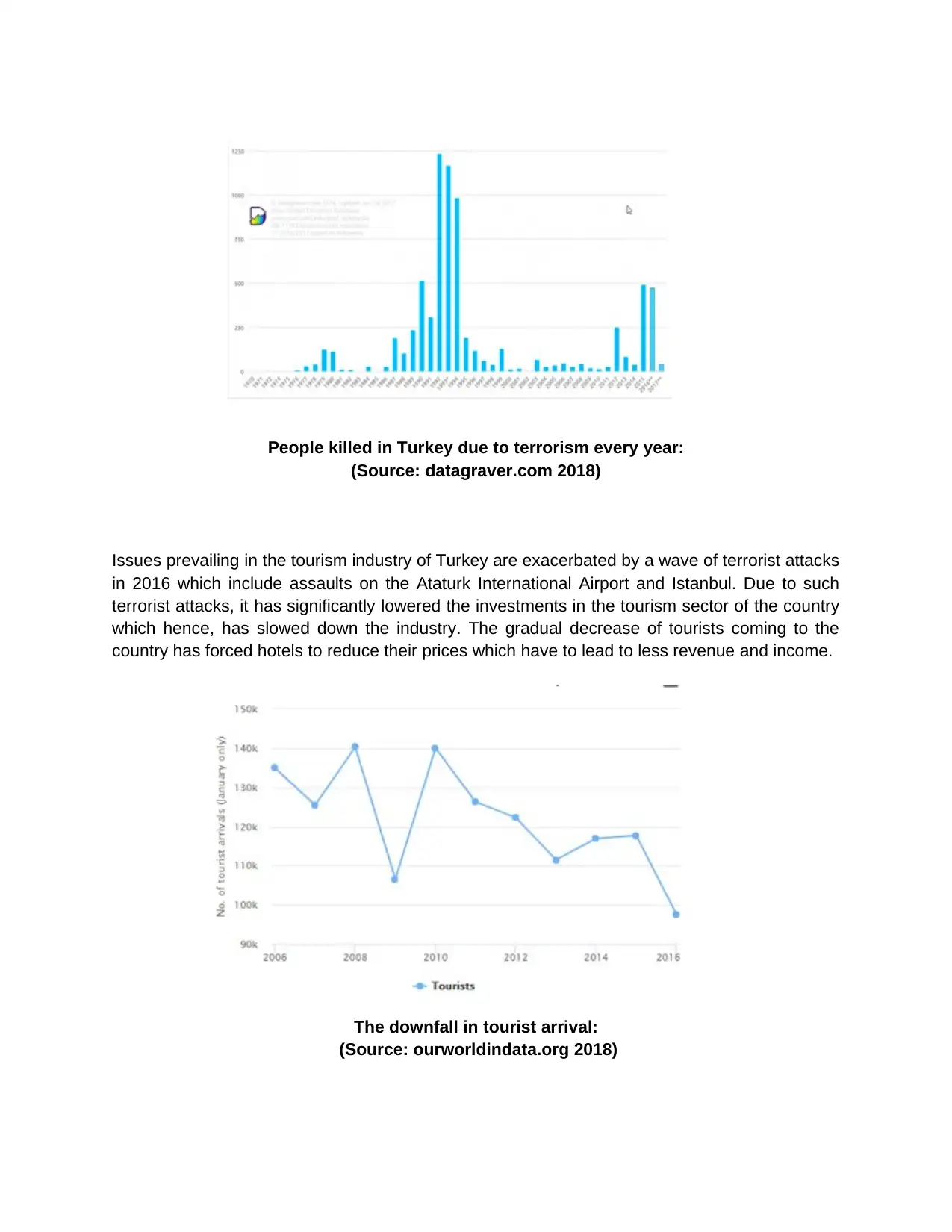
People killed in Turkey due to terrorism every year:
(Source: datagraver.com 2018)
Issues prevailing in the tourism industry of Turkey are exacerbated by a wave of terrorist attacks
in 2016 which include assaults on the Ataturk International Airport and Istanbul. Due to such
terrorist attacks, it has significantly lowered the investments in the tourism sector of the country
which hence, has slowed down the industry. The gradual decrease of tourists coming to the
country has forced hotels to reduce their prices which have to lead to less revenue and income.
The downfall in tourist arrival:
(Source: ourworldindata.org 2018)
(Source: datagraver.com 2018)
Issues prevailing in the tourism industry of Turkey are exacerbated by a wave of terrorist attacks
in 2016 which include assaults on the Ataturk International Airport and Istanbul. Due to such
terrorist attacks, it has significantly lowered the investments in the tourism sector of the country
which hence, has slowed down the industry. The gradual decrease of tourists coming to the
country has forced hotels to reduce their prices which have to lead to less revenue and income.
The downfall in tourist arrival:
(Source: ourworldindata.org 2018)
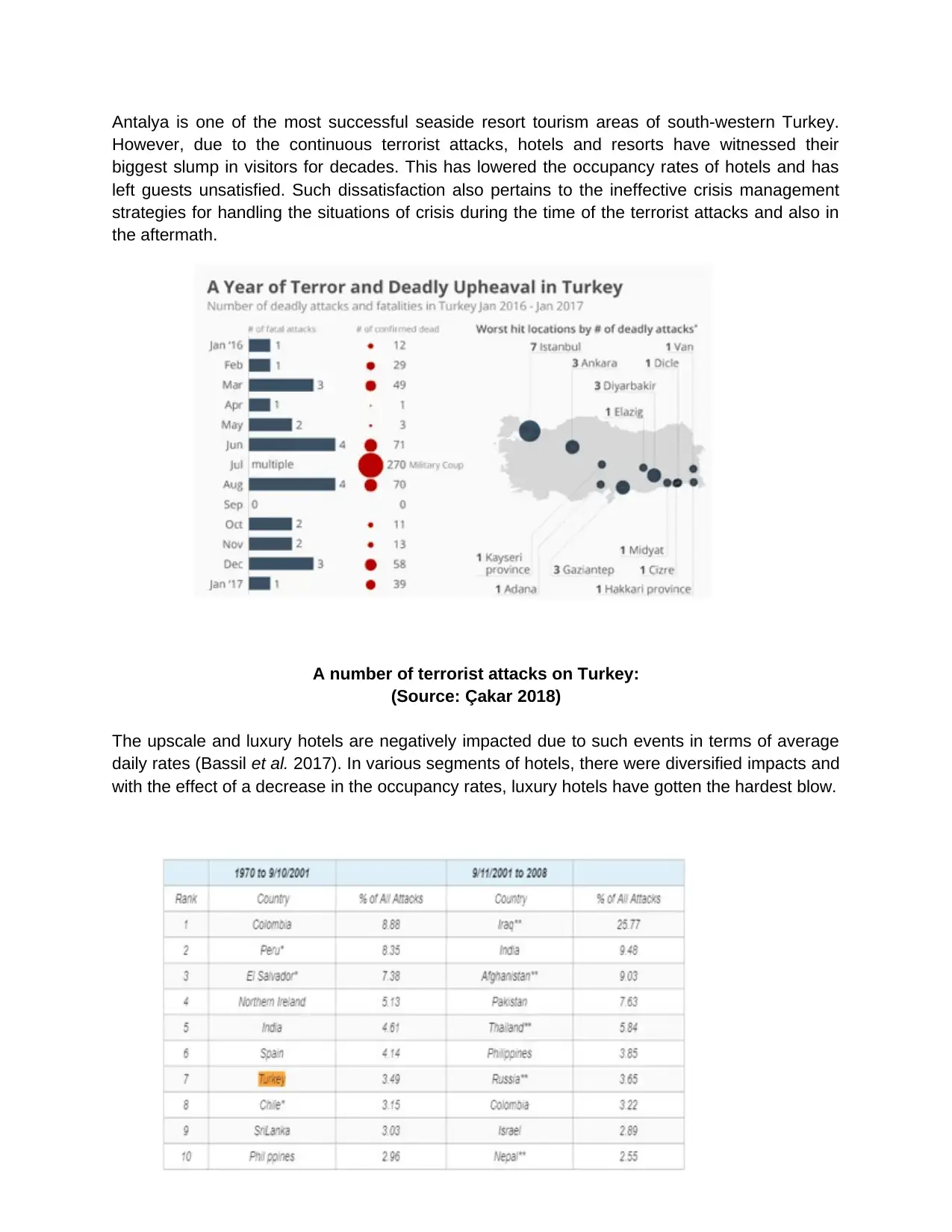
Antalya is one of the most successful seaside resort tourism areas of south-western Turkey.
However, due to the continuous terrorist attacks, hotels and resorts have witnessed their
biggest slump in visitors for decades. This has lowered the occupancy rates of hotels and has
left guests unsatisfied. Such dissatisfaction also pertains to the ineffective crisis management
strategies for handling the situations of crisis during the time of the terrorist attacks and also in
the aftermath.
A number of terrorist attacks on Turkey:
(Source: Çakar 2018)
The upscale and luxury hotels are negatively impacted due to such events in terms of average
daily rates (Bassil et al. 2017). In various segments of hotels, there were diversified impacts and
with the effect of a decrease in the occupancy rates, luxury hotels have gotten the hardest blow.
However, due to the continuous terrorist attacks, hotels and resorts have witnessed their
biggest slump in visitors for decades. This has lowered the occupancy rates of hotels and has
left guests unsatisfied. Such dissatisfaction also pertains to the ineffective crisis management
strategies for handling the situations of crisis during the time of the terrorist attacks and also in
the aftermath.
A number of terrorist attacks on Turkey:
(Source: Çakar 2018)
The upscale and luxury hotels are negatively impacted due to such events in terms of average
daily rates (Bassil et al. 2017). In various segments of hotels, there were diversified impacts and
with the effect of a decrease in the occupancy rates, luxury hotels have gotten the hardest blow.
⊘ This is a preview!⊘
Do you want full access?
Subscribe today to unlock all pages.

Trusted by 1+ million students worldwide
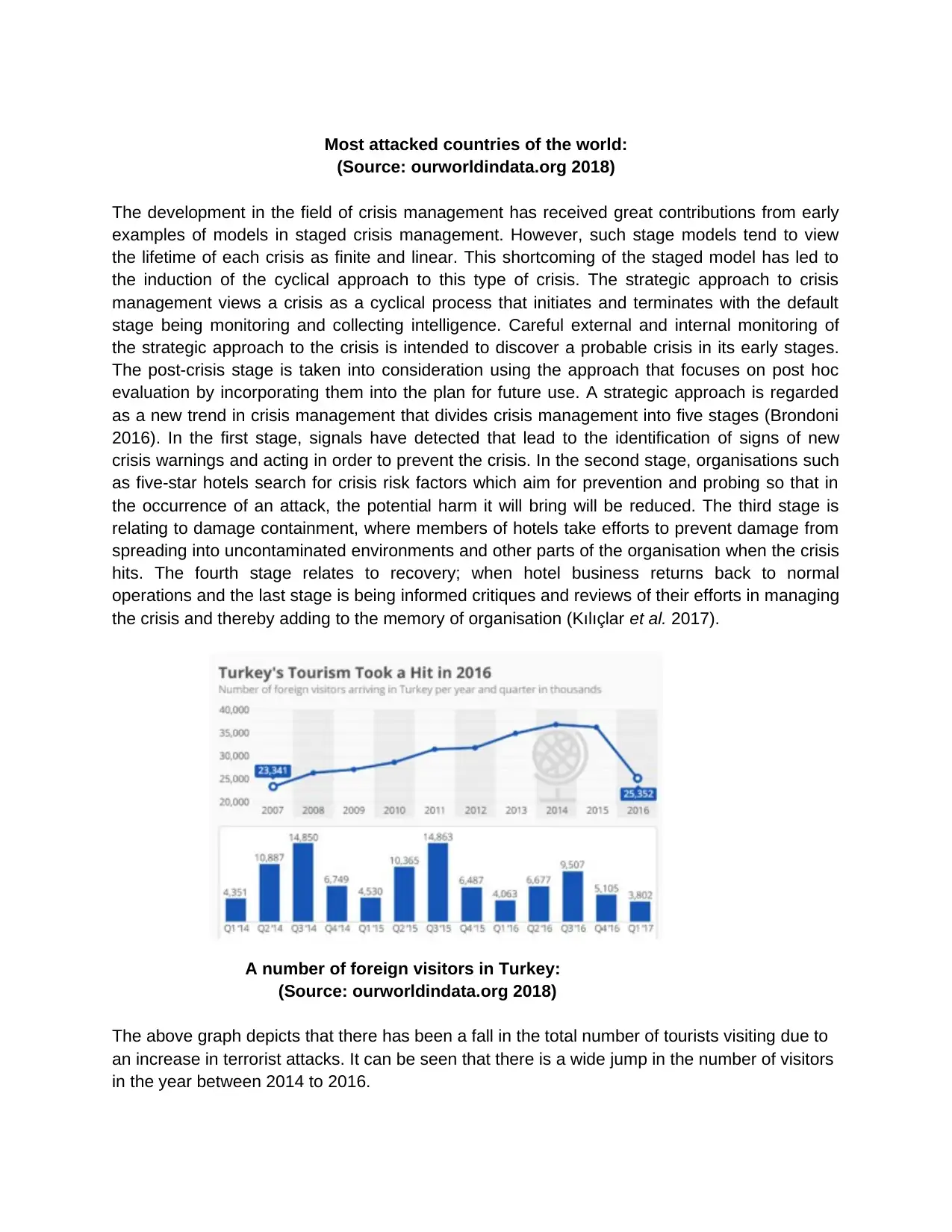
Most attacked countries of the world:
(Source: ourworldindata.org 2018)
The development in the field of crisis management has received great contributions from early
examples of models in staged crisis management. However, such stage models tend to view
the lifetime of each crisis as finite and linear. This shortcoming of the staged model has led to
the induction of the cyclical approach to this type of crisis. The strategic approach to crisis
management views a crisis as a cyclical process that initiates and terminates with the default
stage being monitoring and collecting intelligence. Careful external and internal monitoring of
the strategic approach to the crisis is intended to discover a probable crisis in its early stages.
The post-crisis stage is taken into consideration using the approach that focuses on post hoc
evaluation by incorporating them into the plan for future use. A strategic approach is regarded
as a new trend in crisis management that divides crisis management into five stages (Brondoni
2016). In the first stage, signals have detected that lead to the identification of signs of new
crisis warnings and acting in order to prevent the crisis. In the second stage, organisations such
as five-star hotels search for crisis risk factors which aim for prevention and probing so that in
the occurrence of an attack, the potential harm it will bring will be reduced. The third stage is
relating to damage containment, where members of hotels take efforts to prevent damage from
spreading into uncontaminated environments and other parts of the organisation when the crisis
hits. The fourth stage relates to recovery; when hotel business returns back to normal
operations and the last stage is being informed critiques and reviews of their efforts in managing
the crisis and thereby adding to the memory of organisation (Kılıçlar et al. 2017).
A number of foreign visitors in Turkey:
(Source: ourworldindata.org 2018)
The above graph depicts that there has been a fall in the total number of tourists visiting due to
an increase in terrorist attacks. It can be seen that there is a wide jump in the number of visitors
in the year between 2014 to 2016.
(Source: ourworldindata.org 2018)
The development in the field of crisis management has received great contributions from early
examples of models in staged crisis management. However, such stage models tend to view
the lifetime of each crisis as finite and linear. This shortcoming of the staged model has led to
the induction of the cyclical approach to this type of crisis. The strategic approach to crisis
management views a crisis as a cyclical process that initiates and terminates with the default
stage being monitoring and collecting intelligence. Careful external and internal monitoring of
the strategic approach to the crisis is intended to discover a probable crisis in its early stages.
The post-crisis stage is taken into consideration using the approach that focuses on post hoc
evaluation by incorporating them into the plan for future use. A strategic approach is regarded
as a new trend in crisis management that divides crisis management into five stages (Brondoni
2016). In the first stage, signals have detected that lead to the identification of signs of new
crisis warnings and acting in order to prevent the crisis. In the second stage, organisations such
as five-star hotels search for crisis risk factors which aim for prevention and probing so that in
the occurrence of an attack, the potential harm it will bring will be reduced. The third stage is
relating to damage containment, where members of hotels take efforts to prevent damage from
spreading into uncontaminated environments and other parts of the organisation when the crisis
hits. The fourth stage relates to recovery; when hotel business returns back to normal
operations and the last stage is being informed critiques and reviews of their efforts in managing
the crisis and thereby adding to the memory of organisation (Kılıçlar et al. 2017).
A number of foreign visitors in Turkey:
(Source: ourworldindata.org 2018)
The above graph depicts that there has been a fall in the total number of tourists visiting due to
an increase in terrorist attacks. It can be seen that there is a wide jump in the number of visitors
in the year between 2014 to 2016.
Paraphrase This Document
Need a fresh take? Get an instant paraphrase of this document with our AI Paraphraser
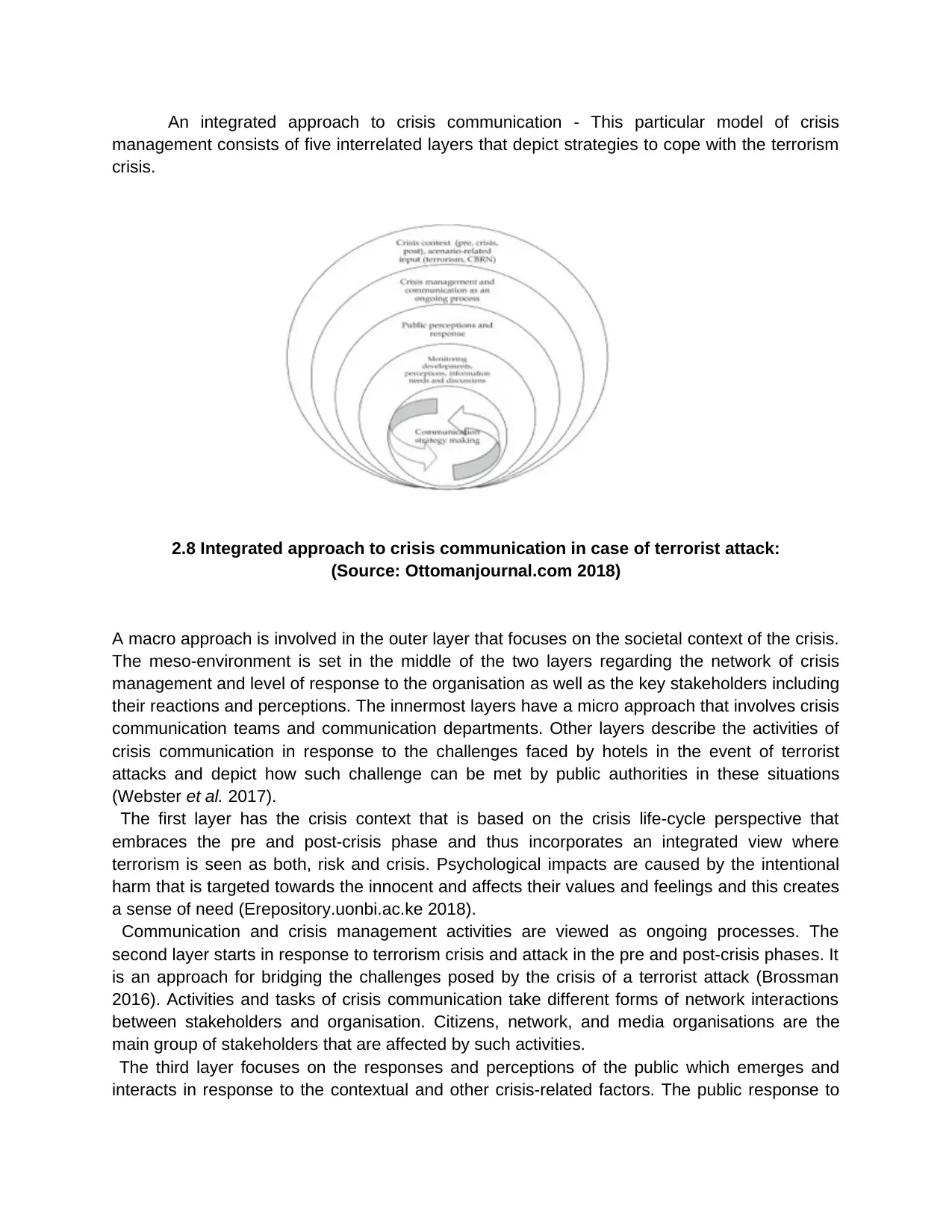
An integrated approach to crisis communication - This particular model of crisis
management consists of five interrelated layers that depict strategies to cope with the terrorism
crisis.
2.8 Integrated approach to crisis communication in case of terrorist attack:
(Source: Ottomanjournal.com 2018)
A macro approach is involved in the outer layer that focuses on the societal context of the crisis.
The meso-environment is set in the middle of the two layers regarding the network of crisis
management and level of response to the organisation as well as the key stakeholders including
their reactions and perceptions. The innermost layers have a micro approach that involves crisis
communication teams and communication departments. Other layers describe the activities of
crisis communication in response to the challenges faced by hotels in the event of terrorist
attacks and depict how such challenge can be met by public authorities in these situations
(Webster et al. 2017).
The first layer has the crisis context that is based on the crisis life-cycle perspective that
embraces the pre and post-crisis phase and thus incorporates an integrated view where
terrorism is seen as both, risk and crisis. Psychological impacts are caused by the intentional
harm that is targeted towards the innocent and affects their values and feelings and this creates
a sense of need (Erepository.uonbi.ac.ke 2018).
Communication and crisis management activities are viewed as ongoing processes. The
second layer starts in response to terrorism crisis and attack in the pre and post-crisis phases. It
is an approach for bridging the challenges posed by the crisis of a terrorist attack (Brossman
2016). Activities and tasks of crisis communication take different forms of network interactions
between stakeholders and organisation. Citizens, network, and media organisations are the
main group of stakeholders that are affected by such activities.
The third layer focuses on the responses and perceptions of the public which emerges and
interacts in response to the contextual and other crisis-related factors. The public response to
management consists of five interrelated layers that depict strategies to cope with the terrorism
crisis.
2.8 Integrated approach to crisis communication in case of terrorist attack:
(Source: Ottomanjournal.com 2018)
A macro approach is involved in the outer layer that focuses on the societal context of the crisis.
The meso-environment is set in the middle of the two layers regarding the network of crisis
management and level of response to the organisation as well as the key stakeholders including
their reactions and perceptions. The innermost layers have a micro approach that involves crisis
communication teams and communication departments. Other layers describe the activities of
crisis communication in response to the challenges faced by hotels in the event of terrorist
attacks and depict how such challenge can be met by public authorities in these situations
(Webster et al. 2017).
The first layer has the crisis context that is based on the crisis life-cycle perspective that
embraces the pre and post-crisis phase and thus incorporates an integrated view where
terrorism is seen as both, risk and crisis. Psychological impacts are caused by the intentional
harm that is targeted towards the innocent and affects their values and feelings and this creates
a sense of need (Erepository.uonbi.ac.ke 2018).
Communication and crisis management activities are viewed as ongoing processes. The
second layer starts in response to terrorism crisis and attack in the pre and post-crisis phases. It
is an approach for bridging the challenges posed by the crisis of a terrorist attack (Brossman
2016). Activities and tasks of crisis communication take different forms of network interactions
between stakeholders and organisation. Citizens, network, and media organisations are the
main group of stakeholders that are affected by such activities.
The third layer focuses on the responses and perceptions of the public which emerges and
interacts in response to the contextual and other crisis-related factors. The public response to
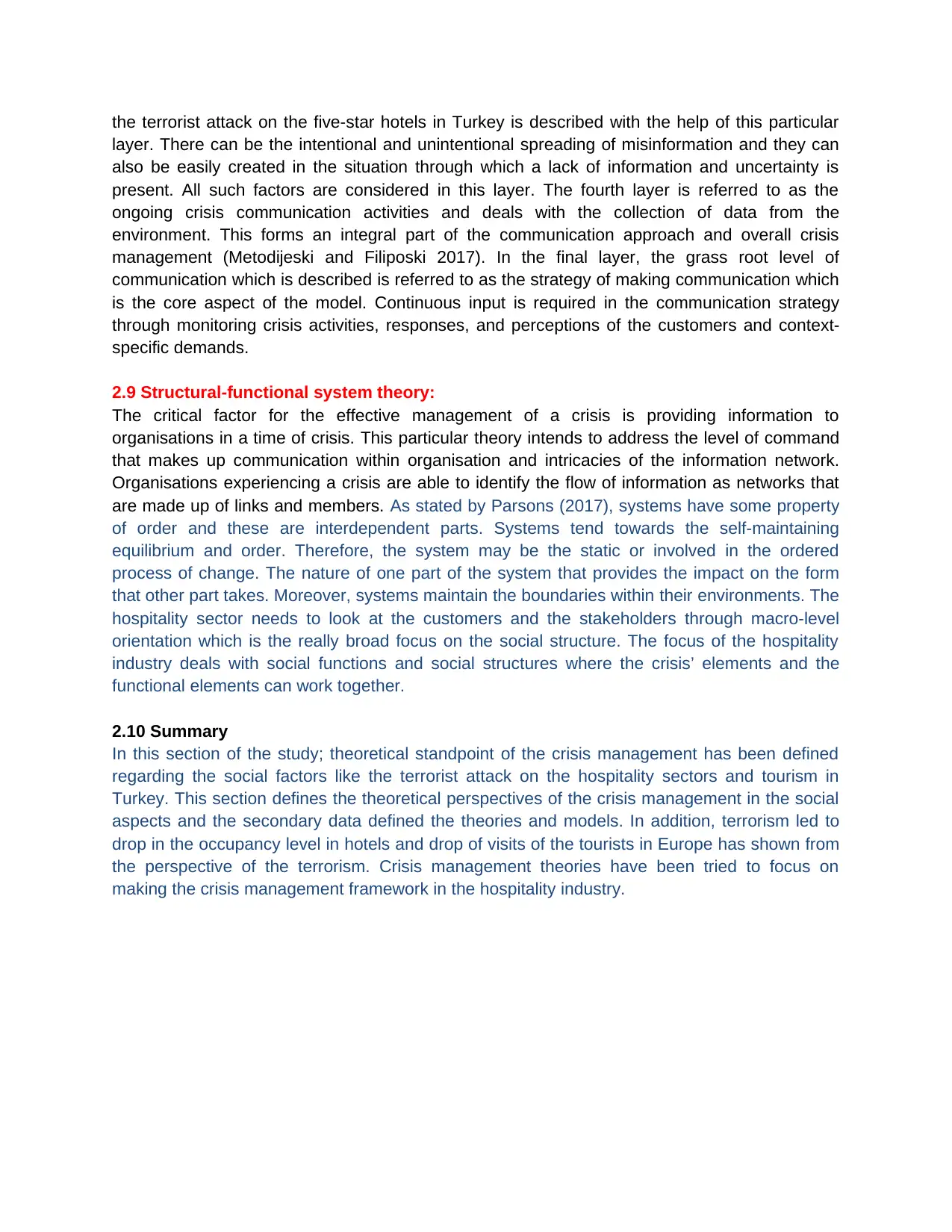
the terrorist attack on the five-star hotels in Turkey is described with the help of this particular
layer. There can be the intentional and unintentional spreading of misinformation and they can
also be easily created in the situation through which a lack of information and uncertainty is
present. All such factors are considered in this layer. The fourth layer is referred to as the
ongoing crisis communication activities and deals with the collection of data from the
environment. This forms an integral part of the communication approach and overall crisis
management (Metodijeski and Filiposki 2017). In the final layer, the grass root level of
communication which is described is referred to as the strategy of making communication which
is the core aspect of the model. Continuous input is required in the communication strategy
through monitoring crisis activities, responses, and perceptions of the customers and context-
specific demands.
2.9 Structural-functional system theory:
The critical factor for the effective management of a crisis is providing information to
organisations in a time of crisis. This particular theory intends to address the level of command
that makes up communication within organisation and intricacies of the information network.
Organisations experiencing a crisis are able to identify the flow of information as networks that
are made up of links and members. As stated by Parsons (2017), systems have some property
of order and these are interdependent parts. Systems tend towards the self-maintaining
equilibrium and order. Therefore, the system may be the static or involved in the ordered
process of change. The nature of one part of the system that provides the impact on the form
that other part takes. Moreover, systems maintain the boundaries within their environments. The
hospitality sector needs to look at the customers and the stakeholders through macro-level
orientation which is the really broad focus on the social structure. The focus of the hospitality
industry deals with social functions and social structures where the crisis’ elements and the
functional elements can work together.
2.10 Summary
In this section of the study; theoretical standpoint of the crisis management has been defined
regarding the social factors like the terrorist attack on the hospitality sectors and tourism in
Turkey. This section defines the theoretical perspectives of the crisis management in the social
aspects and the secondary data defined the theories and models. In addition, terrorism led to
drop in the occupancy level in hotels and drop of visits of the tourists in Europe has shown from
the perspective of the terrorism. Crisis management theories have been tried to focus on
making the crisis management framework in the hospitality industry.
layer. There can be the intentional and unintentional spreading of misinformation and they can
also be easily created in the situation through which a lack of information and uncertainty is
present. All such factors are considered in this layer. The fourth layer is referred to as the
ongoing crisis communication activities and deals with the collection of data from the
environment. This forms an integral part of the communication approach and overall crisis
management (Metodijeski and Filiposki 2017). In the final layer, the grass root level of
communication which is described is referred to as the strategy of making communication which
is the core aspect of the model. Continuous input is required in the communication strategy
through monitoring crisis activities, responses, and perceptions of the customers and context-
specific demands.
2.9 Structural-functional system theory:
The critical factor for the effective management of a crisis is providing information to
organisations in a time of crisis. This particular theory intends to address the level of command
that makes up communication within organisation and intricacies of the information network.
Organisations experiencing a crisis are able to identify the flow of information as networks that
are made up of links and members. As stated by Parsons (2017), systems have some property
of order and these are interdependent parts. Systems tend towards the self-maintaining
equilibrium and order. Therefore, the system may be the static or involved in the ordered
process of change. The nature of one part of the system that provides the impact on the form
that other part takes. Moreover, systems maintain the boundaries within their environments. The
hospitality sector needs to look at the customers and the stakeholders through macro-level
orientation which is the really broad focus on the social structure. The focus of the hospitality
industry deals with social functions and social structures where the crisis’ elements and the
functional elements can work together.
2.10 Summary
In this section of the study; theoretical standpoint of the crisis management has been defined
regarding the social factors like the terrorist attack on the hospitality sectors and tourism in
Turkey. This section defines the theoretical perspectives of the crisis management in the social
aspects and the secondary data defined the theories and models. In addition, terrorism led to
drop in the occupancy level in hotels and drop of visits of the tourists in Europe has shown from
the perspective of the terrorism. Crisis management theories have been tried to focus on
making the crisis management framework in the hospitality industry.
⊘ This is a preview!⊘
Do you want full access?
Subscribe today to unlock all pages.

Trusted by 1+ million students worldwide
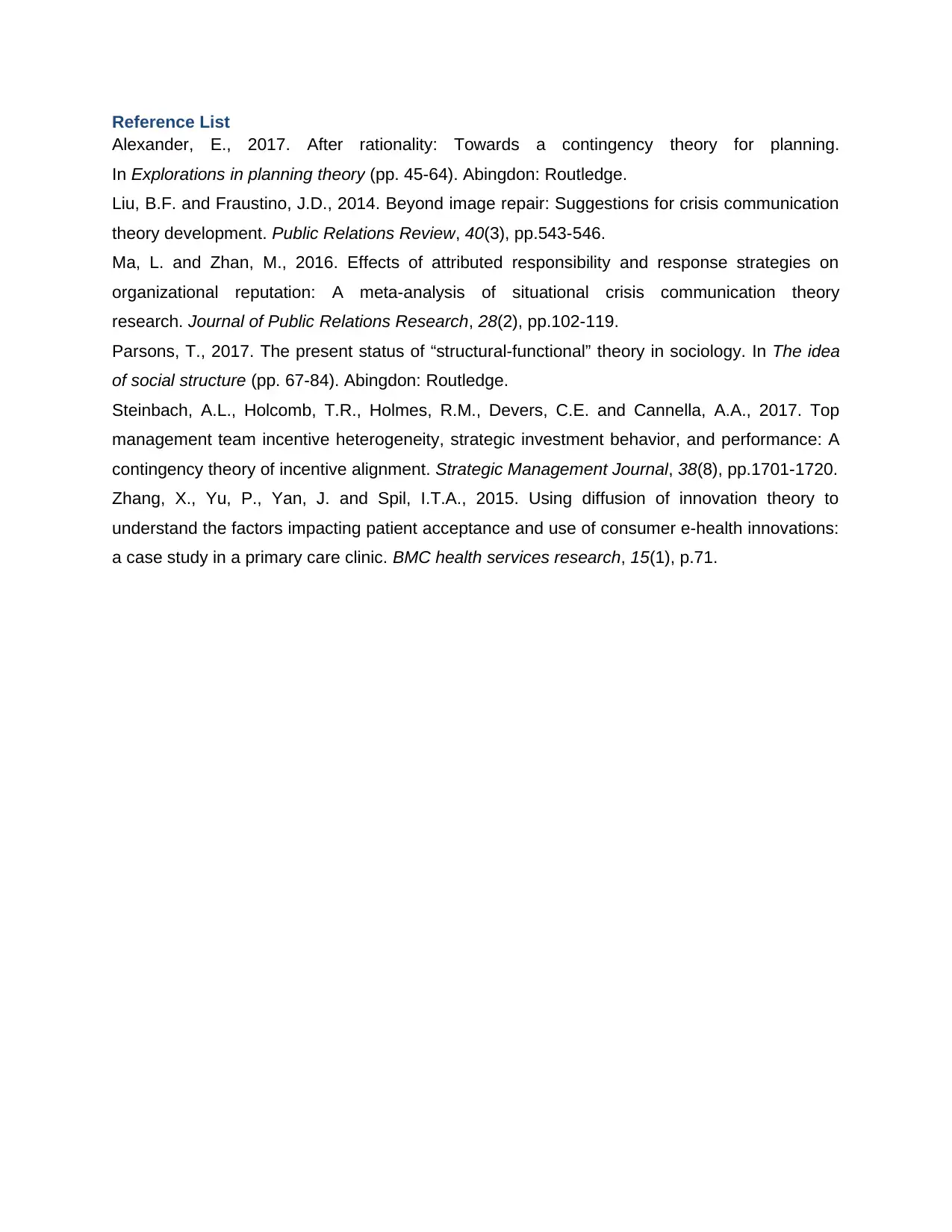
Reference List
Alexander, E., 2017. After rationality: Towards a contingency theory for planning.
In Explorations in planning theory (pp. 45-64). Abingdon: Routledge.
Liu, B.F. and Fraustino, J.D., 2014. Beyond image repair: Suggestions for crisis communication
theory development. Public Relations Review, 40(3), pp.543-546.
Ma, L. and Zhan, M., 2016. Effects of attributed responsibility and response strategies on
organizational reputation: A meta-analysis of situational crisis communication theory
research. Journal of Public Relations Research, 28(2), pp.102-119.
Parsons, T., 2017. The present status of “structural-functional” theory in sociology. In The idea
of social structure (pp. 67-84). Abingdon: Routledge.
Steinbach, A.L., Holcomb, T.R., Holmes, R.M., Devers, C.E. and Cannella, A.A., 2017. Top
management team incentive heterogeneity, strategic investment behavior, and performance: A
contingency theory of incentive alignment. Strategic Management Journal, 38(8), pp.1701-1720.
Zhang, X., Yu, P., Yan, J. and Spil, I.T.A., 2015. Using diffusion of innovation theory to
understand the factors impacting patient acceptance and use of consumer e-health innovations:
a case study in a primary care clinic. BMC health services research, 15(1), p.71.
Alexander, E., 2017. After rationality: Towards a contingency theory for planning.
In Explorations in planning theory (pp. 45-64). Abingdon: Routledge.
Liu, B.F. and Fraustino, J.D., 2014. Beyond image repair: Suggestions for crisis communication
theory development. Public Relations Review, 40(3), pp.543-546.
Ma, L. and Zhan, M., 2016. Effects of attributed responsibility and response strategies on
organizational reputation: A meta-analysis of situational crisis communication theory
research. Journal of Public Relations Research, 28(2), pp.102-119.
Parsons, T., 2017. The present status of “structural-functional” theory in sociology. In The idea
of social structure (pp. 67-84). Abingdon: Routledge.
Steinbach, A.L., Holcomb, T.R., Holmes, R.M., Devers, C.E. and Cannella, A.A., 2017. Top
management team incentive heterogeneity, strategic investment behavior, and performance: A
contingency theory of incentive alignment. Strategic Management Journal, 38(8), pp.1701-1720.
Zhang, X., Yu, P., Yan, J. and Spil, I.T.A., 2015. Using diffusion of innovation theory to
understand the factors impacting patient acceptance and use of consumer e-health innovations:
a case study in a primary care clinic. BMC health services research, 15(1), p.71.
1 out of 10
Related Documents
Your All-in-One AI-Powered Toolkit for Academic Success.
+13062052269
info@desklib.com
Available 24*7 on WhatsApp / Email
![[object Object]](/_next/static/media/star-bottom.7253800d.svg)
Unlock your academic potential
Copyright © 2020–2025 A2Z Services. All Rights Reserved. Developed and managed by ZUCOL.



